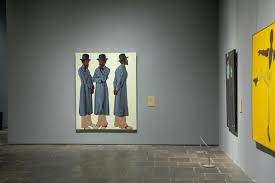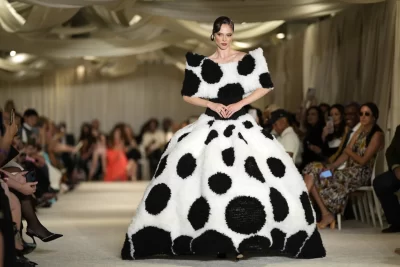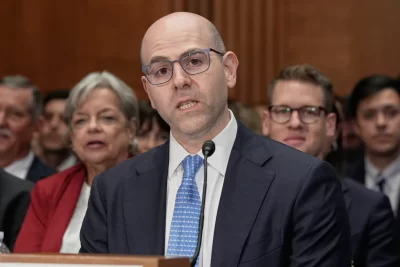
A dozen years ago, Barkley L. Hendricks, the pioneering portrait artist known for vivid, stylish paintings of Black men and women, stood outside the Frick Collection in Manhattan, known for its works by European Old Masters. He was explaining his love for Rembrandt.
“It’s like good music,” the artist said that day. “You can be replenished every time you hear it.”
By the time Hendricks died in 2017, the art world was finally giving overdue recognition to his work, which applied centuries-old traditions of European painting to depictions of Black figures — friends, relatives or strangers he photographed in the streets with his Polaroid. Still, curators say, he’d likely have never imagined that in 2023, he’d be the first artist of color to have a solo show at the 88-year-old Frick.
“I think this is probably beyond his wildest dreams,” said co-curator Antwaun Sargent as he surveyed the room ahead of the show’s opening late last week, “to be showing in the institution that he so revered.”
It’s not surprising that Hendricks would have loved the Frick, given his admiration for artists like Rembrandt, Van Dyck, Van Eyck, Velásquez and others. What is more unusual is that a museum focusing on the 14th through 19th centuries would devote a show to a contemporary portraitist like Hendricks. The Frick does not collect works made after 1900.
“This is as much about the story of the Frick and its identity and place in New York City,” Ng said in an interview ahead of the opening. She said the exhibit, along with celebrating Hendricks, celebrates the museum “as an institution that inspired people like Barkley, who would seem to have nothing to do with historic art as a contemporary artist, but went on to mine the Frick as a place for his own innovations.”
The exhibit is also the last major show to take place at the museum’s temporary digs, Frick Madison, before a return next year to its grand Beaux-Arts setting on Fifth Avenue following a renovation.
The Hendricks show, which runs through Jan. 7, features 14 large paintings, beginning with the noted early work “Lawdy Mama” (1968.) It’s a portrait that has evoked to many, Hendricks has noted, the activist Angela Davis — but is actually the artist’s cousin, Kathy Williams. She is surrounded by gold leaf akin to a Byzantine icon, with her Afro appearing like a halo. The title was inspired by Nina Simone lyrics.
Born in Philadelphia, Hendricks studied at the Pennsylvania Academy of the Fine Arts and later attended Yale’s school of art, after which he joined the art department at Connecticut College, teaching there from 1972 until 2010.
The exhibit’s accompanying catalog contains testimonials from artists and other luminaries speaking of his influence, including Kehinde Wiley, painter of the famous Barack Obama portrait, who begins simply: “No figurative artist can approach painting without considering Barkley Hendricks.”
Among the works on display is “Miss T,” the first in a series of what Hendricks called “former lovers/friends,” this time an old girlfriend. Nearby, “Woody” features a male dancer in a yellow leotard, arms and right leg extended wide, against the same bright yellow background. It recalls the movement of an Alvin Ailey dancer, perhaps, but is actually of Woodruff Wilson, a dancer Hendricks likely photographed on the grounds of Connecticut College.
The yellow-on-yellow composition echoes Hendricks’ white-on-white paintings, which fill their own small room. “Steve” depicts a man in a white trench coat and white trousers with a toothpick in his mouth. His sunglasses reflect the buildings outside Hendricks’ studio, and even contain a tiny reflection of the artist himself.\
“What I love about this room,” says co-curator Sargent, who is a director at the Gagosian gallery, “is that the flesh tones are different in each of these images. It allows us to think about this idea of the person and their individuality.”
Hendricks did not paint famous people. “I just think he painted what was around him,” Sargent says. “His world, strangers, or people in the neighborhood.” He recounts that when Hendricks traveled in Europe and examined portraits in great museums of royalty and nobility, “he said upon returning, ‘But where are MY people?’” And he sought to portray them.
Although he based his paintings on photos, Hendricks often embellished them later, adding details to express personality. For “Ma Petite Kumquat,” a 1983 portrait of his wife, Susan, he photographed her dressed all in black, and in the painting added colorful details like furry leg warmers, a green cord and tassel, red-and-green ribbon bows on her shoes — and a kumquat in her hand, to add a warm color.
Similarly, Hendricks added eyeglasses and a tambourine to the portrait “Blood (Donald Formey),” featuring a former student of Hendricks at Connecticut College, dressed in a reddish plaid jacket.
Ng quotes Formey, who came by the museum to see his portrait last week, as saying Hendricks, in choosing to paint him, “had made him feel no longer invisible — like it was giving him this sort of personhood. It was so powerful for him.”





